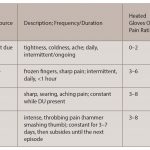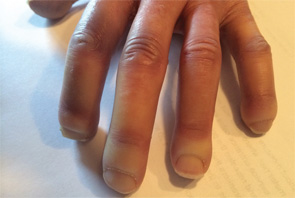
Acroosteolysis of the hands in a patient with scleroderma.
Image Credit: Lauren Tarsi
Scleroderma is a rare rheumatologic autoimmune disease that affects the skin and can also affect other organs. Due to excess formation of scar tissue, blood flow to the extremities is decreased, primarily to the hands, and tissues often become hypoxic, resulting in sclerodactyly and proximal skin involvement.2 The incidence of scleroderma in the U.S. is 50–300 cases per 1 million, and it most commonly affects women from age 30–50.1
There are two main types of scleroderma: localized and systemic. Localized scleroderma is a milder form of the disease, normally affecting the skin and less commonly, the muscles, joints and bones. Tightening of the skin usually occurs on the hands and face, and the skin often appears shiny.
Systemic scleroderma is a more severe and progressive form of the disease and can affect all internal organs, including the lungs, liver, heart, kidneys, esophagus and bowels. This type of scleroderma can be life threatening or may cause severe complications.1,3
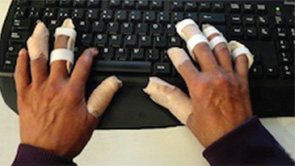
Adaptive equipment fosters functional independence in activities of daily living: Finger splints facilitate use of a computer keyboard.
There’s no cure for scleroderma; however, many patients benefit from physical and occupational therapy to address impairments commonly associated with the disease.
Acroosteolysis, Fatigue & Other Complications
Acroosteolysis, found in 20–25% of patients with systemic scleroderma, is a disease that causes a destructive lytic change to the distal phalanges, causing the bone to shorten (see Figure 1).2 On X-rays, the distal phalanges take the shape of a small pyramid or a flattened ridge.
One of the biggest limiting factors for patients with scleroderma is fatigue, either stemming from the disease itself or due to the side effects of medication.6,8 Fatigue can sometimes make routine activities of daily living (ADLs) difficult.6,11 Patients may not be able to work to the extent that they used to or will require additional time or more frequent rest breaks, depending on their occupational requirements.
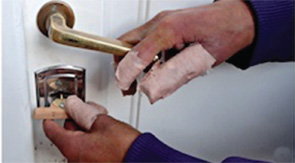
This photo shows a key holder with a built-up handle.
Ulcers on the fingers and toes are a common problem and are evident in more than half of patients with scleroderma. These ulcers develop due to repeated microtrauma and increased use of the hands, underlying calcinosis and impaired blood flow.5 It’s critical that ulcers be managed immediately. Educating the patient to recognize and immediately report these ulcers is an important aspect of care. The longer the ischemia continues into the digits, the higher the risk that the ulcer won’t heal and, ultimately, will develop into a chronic ulcer.6
Primary Therapy Goals
The main goal of therapy for patients with scleroderma is to retain range of motion. Because the skin can become taut, the patient may experience a permanent loss in range of motion.9
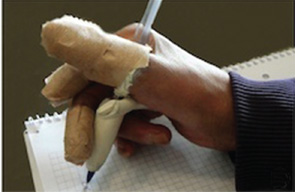
Enlarged grips aid writing. Image Credit: acr image bank
Both occupational therapy and physical therapy play vital roles in rehabilitation, helping prevent contractures, maintain quality of life and assist in returning to prior levels of function.
It’s important to restore the blood flow to the distal upper extremities and increase distal circulation prior to beginning a therapy session.1 Heat packs are commonly used to increase blood flow and improve circulation before exercises are started. However, heat packs must be used with caution if the patient has any loss of sensation due to the risk of skin burns.9
Therapy concentrates on stretching the wrist, fingers, shoulders and hands. Maintaining flexion and extension of the joints is key to keeping the joints mobile and functional. In addition to a home stretching program, it’s useful to provide gentle, manual passive range of motion to all stiff joints.12
Splints have been developed and engineered for patients to help prevent the loss of range of motion and decrease the risk of contractures. Splints can be worn during the day to help with activities or used at night as resting splints.6
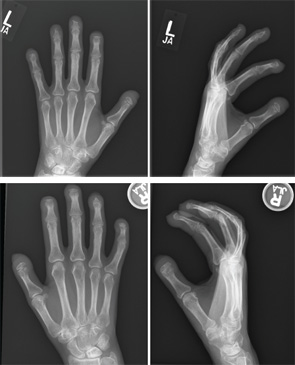
Figures 1A, B, C & D: P/A and lateral X-ray views of acroosteolysis in both hands.
Wrist and hand range of motion are important to maintain, but strengthening is also critical. A dynamometer can be used to assess the grip strength of a patient and obtain a comparison between sides. This can be used as a baseline to track progress with strength over the course of a therapy program. Grip strength is a functional measure that people use in their everyday life, so incorporating this into the therapy program is essential. Useful exercises include squeezing rice and putty.
Other joints, such as the shoulders and hips, may be stiff and weak. Thus, it’s useful to include exercises that gently stretch the pectoralis major and minor muscles, as well as the hip abductors.
Effectiveness Demonstrated
How effective are rehabilitation programs? One study compared the effectiveness of twice-weekly connective tissue massage and McMennell joint manipulation for nine weeks, vs. a home exercise program.10 The McMennell manipulations helped restore normal joint movement in all directions and were applied to the wrist, metacarpophalangeal and interphalangeal joints.
Due to the nature of the disease and how it affects the hands, any job requiring pinching or gripping may be particularly difficult. For opening jars or unhooking clips in the workplace, grippers or tourniquets can help patients maintain a better grip on the object. Any job that requires careful manual dexterity will often be more challenging for the patient with scleroderma.
In another study, the researchers surveyed 27 people with scleroderma to ascertain common work limitations.11 The two leading complaints were working with keyboards (88% of respondents) and discomfort with the type of chair used (85% of respondents). Due to limited mobility and dexterity of the hands, keyboard typing can pose a problem, and stiff, swollen hands make typing accuracy difficult. Ergonomic keyboards are recommended to ease pain, but some patients report little effectiveness with adaptive keyboards.
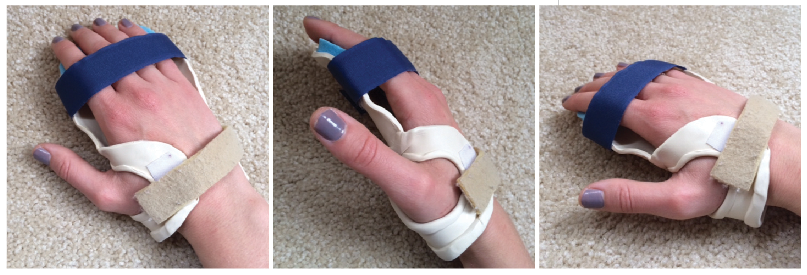
Figures 2A, B & C: Resting splints for the wrist and fingers used to prevent contractures.
Case Study
A 46-year-old female presented to her primary care physician (PCP) in May 2005, and subsequently to a rheumatologist, after she noticed stiffening in her right hand. The diagnosis of early scleroderma was made based upon clinical findings of hand puffiness and abnormal serologic studies.4 She was subsequently referred to physical therapy. Her main complaints were stiffness in her hands, wrist, arms, neck and shoulders. The overall stiffness was interfering with her everyday life, especially overhead activities, such as brushing her hair and reaching behind her head. Physical therapy helped her regain her range of motion and mobility. She was discharged to a home exercise program. However, therapy was often restarted during the colder months, when the patient experienced a substantial increase in stiffness.
In March 2014, the patient went for her annual rheumatology checkup, where her physician noticed bilateral tissue thickening in the patient’s hands. An X-ray was ordered, and results confirmed acroosteolysis (see Figure 1). Because there is no cure for this condition, the patient was referred to physical and occupational therapy to address her impairments and functional limitations.
Currently, her main impairments include bilateral ulcers on her hands, for which she uses a topical agent, silver sulfadiazine to assist in healing.7 She reports that the ointment and a fabric Band-Aid generally heal the ulcers in about a week.
The patient’s decrease in range of motion of the hands and fingers makes performing ADLs and other daily tasks much more challenging. This past year, stretching equipment, such as the PowerWeb hand exerciser and the FlexBar resistance device, has been integrated to assist in maintaining her range of motion.
The patient wears custom hand splints that were made for her by an occupational therapist (see Figure 2). She wears them only at night to help prevent contractures. The hard, rigid design of the splints makes them difficult to wear all day while she is busy around the house and at work.
The patient expressed difficulty with overhead motions, and she reported a sense of decreased balance and proprioception since being diagnosed with scleroderma. Her physical therapist has incorporated many balance activities on the DynaDisc and AIREX foam balance pad to help improve her proprioception and coordination. Exercises that focus on lower extremity strengthening have also been incorporated into the program, such as lateral band walks and squats.
In Sum
Rehabilitation and therapy can’t heal scleroderma, but therapy can help maintain and improve the range of motion in the hands and improve the patient’s overall function. Exercising and stretching regularly can help delay, and sometimes prevent, the development of contractures, which can have a severe impact on quality of life.
Prescribing a program early in the course of a patient’s illness that focuses on endurance and strength, in addition to stretching, can help patients maintain their functional status.
The clinical presentation and needs of the patient with scleroderma can vary, which is why every patient should be given an individualized program to help improve their specific symptoms, address limitations and maximize outcomes.
 Lauren Tarsi is in her last year of graduate school at Northeastern University and will graduate with a clinical doctorate in physical therapy in May 2015. Lauren has a strong interest in orthopedic physical therapy and looks forward to starting her career as a physical therapist soon.
Lauren Tarsi is in her last year of graduate school at Northeastern University and will graduate with a clinical doctorate in physical therapy in May 2015. Lauren has a strong interest in orthopedic physical therapy and looks forward to starting her career as a physical therapist soon.
 Marie B. Corkery, PT, DPT, MHS, FAAOMPT, is an associate clinical professor in the Department of Physical Therapy, Movement and Rehabilitation Sciences, Northeastern University, Boston.
Marie B. Corkery, PT, DPT, MHS, FAAOMPT, is an associate clinical professor in the Department of Physical Therapy, Movement and Rehabilitation Sciences, Northeastern University, Boston.
References
- Gabrielli A, Avvedimento E, Krieg T. Scleroderma. N Engl J Med. 2009 May 7:1989–2003.
- Johnstone EM, Hutchinson CE, Vail A, et al. Acro-osteolysis in systemic sclerosis is associated with digital ischaemia and severe calcinosis. Rheumatology (Oxford). 2012 Dec;51(12):1–5.
- Merkel P. Scleroderma (also known as systemic sclerosis). The American College of Rheumatology. Updated February 2013.
- Chung L, Utz PJ. Antibodies in scleroderma: Direct pathogenicity and phenotypic association. Curr Rheumatol Rep. 2004 Apr;6(2):156–163.
- Nitsche A. Raynaud, digital ulcers and calcinosis in scleroderma. Reumatol Clin. 2012 Sep–Oct;8(5):270–277.
- Scleroderma and your healthcare profession. Scleroderma Society. 2013. Accessed on March 29, 2015.
- Kucan J, Robson M, Heggers J, Ko F. Comparison of silver sulfadiazine, povidone-iodine and physiologic saline in the treatment of chronic pressure ulcers. J Am Geriatr Soc. 1981 May;29(5):232–235.
- Scleroderma. National Institute of Arthritis and Musculoskeletal and Skin Diseases. 2012. Accessed on Dec. 17, 2014.
- Casale R, Buonocore M, Matucci-Cerinic M. Systemic sclerosis (scleroderma): An integrated challenge in rehabilitation. Arch Phys Med Rehabil. 1997 Jul;78(7):767–773.
- Bongi SM, Del Rosso A, Galluccio F, et al. Efficacy of connective tissue massage and McMennell joint manipulation in the rehabilitative treatment of the hands in systemic sclerosis. Clin Rheumatol. 2009;28(10):1167–1173.
- Baker NA, Aufman EL, Poole JL. Computer use problems and accommodation strategies at work and home for people with systemic sclerosis: A needs assessment. Am J Occup Ther. 2012 May–Jun;66(3):368–375.
- Mayes MD, Ho KT. Understanding and managing scleroderma. Scleroderma Foundation. Accessed on Dec. 31, 2014.



